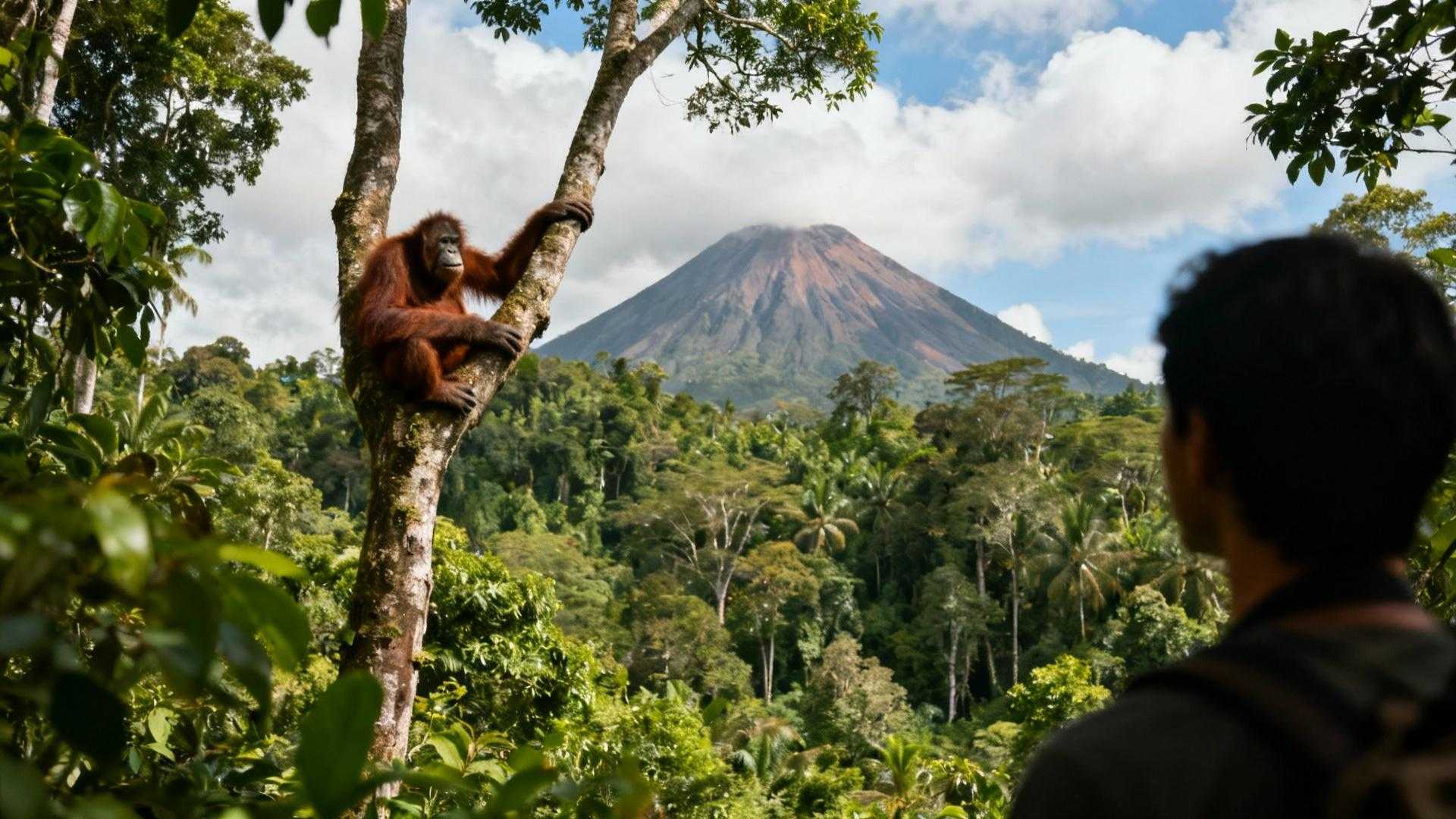I watched a wild Sumatran orangutan swing through the canopy above me in Gunung Leuser National Park, completely alone on the trail except for my local Batak guide. The same week, my friend sent photos from Bali’s Sacred Monkey Forest—surrounded by 300 other tourists fighting for selfies with habituated macaques. That contrast defines why Sumatra receives fewer than 500,000 international visitors annually while Bali drowns under 6.3 million, yet delivers more authentic wildlife encounters, pristine rainforest, and volcanic drama at a fraction of the cost.
This massive Indonesian island—the world’s sixth-largest at 473,481 km²—remains gloriously undiscovered compared to its famous neighbor. While Bali’s beaches now host wall-to-wall resorts and its temples charge premium entrance fees, Sumatra’s jungles still shelter critically endangered species in protected wilderness where you’ll hike for hours without seeing another soul.
Why Bali’s crowds drove me to Sumatra’s empty trails
Bali welcomed 16.4 million total visitors in 2024—creating the exact overcrowding that destroys what made destinations special in the first place. Tanah Lot temple alone sees 2 million annual visitors, while Ubud’s rice terraces now require online reservations during peak season. The island’s tourism success became its greatest weakness.
The numbers that reveal Sumatra’s advantage
Sumatra attracts roughly 70% fewer international tourists than Bali, with Lake Toba region recording just 3.4 million total visitors in 2023—and most were domestic travelers, not foreign crowds. Gunung Leuser National Park, one of Southeast Asia’s most biodiverse rainforests spanning 7,927 km², sees daily visitor numbers you can count on two hands during shoulder season.
Cost comparison that changes everything
I spent $40 daily in Sumatra for comfortable jungle lodge accommodation, three meals, and guided treks—versus the $120+ daily budget Bali now demands for equivalent experiences. Jungle lodges near Bukit Lawang run $25-40 per night with breakfast included, while Bali’s comparable eco-resorts start at $80 and climb rapidly from there.
The endangered species Bali lost that Sumatra protects
Bali’s development erased most large wildlife decades ago. Sumatra remains one of only two places globally where you can witness critically endangered Sumatran orangutans in their natural habitat—with roughly 3,000 individuals surviving in protected forests. My guide Parlindungan Siregar explained how community-based ecotourism funds conservation while limiting visitor numbers to prevent habitat stress.
Wildlife encounters impossible elsewhere
The island shelters the world’s rarest megafauna: Sumatran tigers (fewer than 400 remaining), Sumatran rhinos (under 80 individuals), and Sumatran elephants (around 2,000). These species vanished from Bali generations ago but survive here thanks to indigenous communities protecting ecosystems from mass tourism, similar to how Vietnamese coastal villages guard marine sanctuaries.
Conservation that actually works
Sumatra’s community-based ecotourism model employs local guides, funds habitat protection, and maintains strict visitor limits. Unlike Bali’s commercialized wildlife parks where animals perform tricks, here you track orangutans for hours through genuine rainforest alongside rangers who grew up in these jungles and understand traditional forest management passed down through generations.
Cultural authenticity Bali commercialized away
Bali’s traditional villages now function as open-air museums with entrance fees and souvenir stands. Sumatra’s Batak communities around Lake Toba—the world’s largest volcanic lake at 1,707 km² and 904m elevation—maintain authentic cultural practices because tourism remains secondary to traditional livelihoods like farming and fishing.
Living traditions versus tourist performances
I attended a spontaneous Batak ceremony in a lakeside village where I was the only foreigner present—no tickets, no photographers, just genuine cultural practice. The Minangkabau people in West Sumatra preserve the world’s largest surviving matrilineal society, where women hold property rights and family leadership roles that predate colonial influence by 800+ years.
Volcanic landscapes without the crowds
Lake Toba formed from a supervolcanic eruption 74,000 years ago that nearly caused human extinction. Today its pristine waters and surrounding traditional villages receive a fraction of the tourists crowding Bali’s Mount Batur sunrise treks. The lake’s Samosir Island offers waterfall hikes, hot springs, and traditional Batak architecture with authentic cultural immersion rather than staged photo opportunities.
Practical logistics for October travel
Medan’s Kualanamu International Airport connects via Singapore, Kuala Lumpur, and Jakarta with return flights from the US/UK/Australia typically $700-1,200 depending on season. October sits in shoulder season between dry (May-September) and wet (November-April) periods—offering better accommodation deals before monsoon rains begin intensifying in November.
Getting there before everyone else does
Tourism increased 15-20% annually since 2020 as word spreads about Sumatra’s advantages. Airport expansion planned for 2025-2026 will add direct international routes, likely doubling visitor numbers and prices within 3-4 years. The current window offers authentic experiences before infrastructure development transforms accessibility the way Easter Island’s tourism growth pressured Rapa Nui sacred sites.
Responsible travel that protects what makes it special
Book community-based guides through village cooperatives rather than international tour operators—keeping tourism revenue local and supporting conservation efforts. Respect orangutan viewing protocols (minimum 10-meter distance, no feeding, quiet observation) and recognize that some areas remain intentionally limited to protect fragile ecosystems, just as Thailand’s Bamboo Island preserves pristine beaches through controlled access.
Frequently asked questions about choosing Sumatra over Bali
Is Sumatra safe for independent travelers?
Sumatra offers safe travel for independent visitors using common sense precautions. Hire registered guides for jungle trekking (mandatory in Gunung Leuser), avoid traveling alone in extremely remote areas, and respect local customs in traditional villages. Tourist infrastructure remains less developed than Bali but adequate for adventurous travelers.
What’s the best time to visit for wildlife viewing?
May through September offers the driest weather and best trekking conditions, though orangutans remain visible year-round. April-May and September-October provide shoulder season advantages: fewer tourists, lower prices, and still-reasonable trail conditions before heavy monsoon rains arrive in November.
How much cheaper is Sumatra really compared to Bali?
Expect 60-70% cost savings across accommodation, food, and activities. Jungle lodges run $25-40 versus Bali’s $80+ eco-resorts, local meals cost $2-5 versus $8-15 in Bali tourist areas, and guided wildlife treks average $30-50 daily versus $100+ for comparable Bali nature tours.
